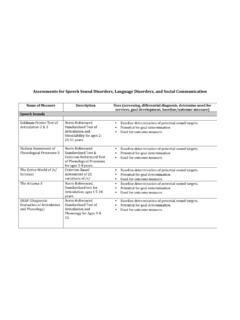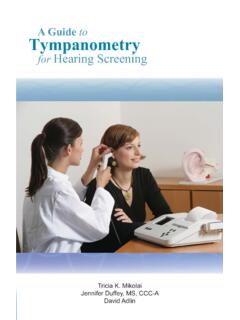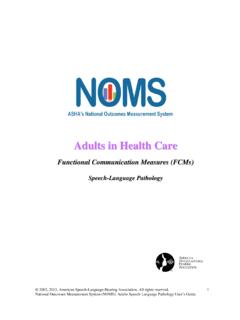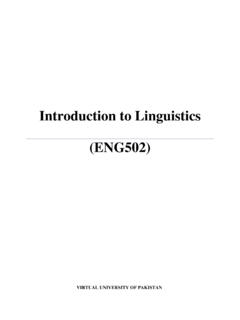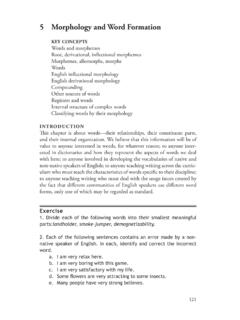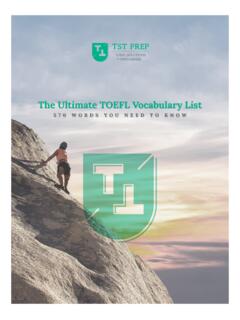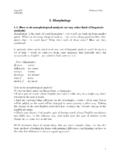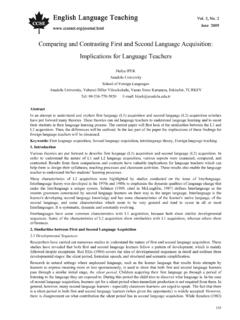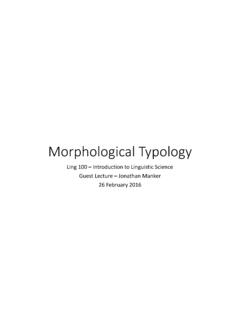Transcription of Morphological Awareness Intervention - University of Oregon
1 TECHNIQUES FOR PROMOTING LANGUAGE AND LITERACY SUCCESSLAURA GREEN, WOMAN S UNIVERSITYJULIE WOLTER, CCC/SLPUTAH STATE UNIVERSITYM orphological Awareness Intervention sidewalkfire fighterlawnmowerbookshelfspacesuitcowboy Green & Wolter (2011)Word Part Combining (in blue)(in green)(in red)anti-(against)-ped (to walk)-ology (study of)micro-(small)-act-(to do)-ion (state of being)un-(not)-dict-(to say)-ness(state of being)re-(repeat)-mot-(to move)-or (doer)Green & Wolter (2011) Morphological Awareness Morphological Awareness can most simply be defined as the study of word structure (Carlisle, 2004) Involves the ability to manipulate and combine morphemes Adding suffixes to base words -> readers learn to see words as the sum of these component parts -> able to infer the meaning and pronunciation of unfamiliar words (Green, 2009).
2 Green & Wolter (2011) Morphological Awareness : Impacts Language and Literacy (Bowers, Kirby, & Deacon, 2010; Carlisle, 1996; 2000; Carlisle 2004; Elbro& Arnback, 1996; Fowler & Liberman, 1995; Goodwin & Ahn, 2010; Reed, 2008; Singson, Mahoney, & Mann, 2000; Windsor, 2000)VocabularyReadingWritingMorphologic al AwarenessGreen & Wolter (2011)Morphology and Vocabulary: The Connection Children increase vocabulary by using the meanings of familiar base words and suffixes to infer the meanings of unfamiliar derivatives. pigletlittle pig -letlittle owletlittle owlGreen & Wolter (2011)Morphology and Vocabulary: Research Approximately 60% of new words acquired by school-age children are morphologically complex (Anglin, 1993). Morphological Awareness treatment resulted in ability to generalize this strategy to infer meaning in unknown words (Bauman, Edwards, & Kameenui, 2003; Baumann, Edwards, Kameenui, & Olejnik, 2002).
3 Green & Wolter (2011)Morphology and Reading: The Connection Decoding Reading ComprehensionMorpheme knowledge /spellingsQuick recognitionEfficient Decoding- tion shun nation, nutrition, conversationMorpheme knowledgeUnderstand vocabularyText comprehension astronaut Ocean The oceanautwas interested in knowing more about fish habitats. naut naut= travelerGreen & Wolter (2011) Morphological Awareness and Literacy Researchers have found strong correlations between Morphological Awareness and success in reading, writing and spelling (Apel& Lawrence, 2011; Carlisle, 2000; Binder & Borecki, 2007; Green, 2009; Jarmulowicz, Hay, Taran& Ethington, 2008; Kirby, Desrochers, Roth & Lai, 2008; McCutchen, Green & Abbott, 2008; Nagy et al., 2006; Schwiebert, Green & McCutchen, 2002; Wolter, Wood & D zatko, 2009).
4 Researchers have reported that knowledge of morphology is significantly related to reading and spelling abilities even in the elementary years ( , Carlisle, 1995; Carlisle & Nomanbhoy,1993; Nunes, Bryant, & Bindman, 2006; Wolter, et al., 2009).Green & Wolter (2011)Morphology and Writing: The Connection morphemes with different pronunciations in different contexts maintain a constant spelling(sign/signature).Our writing system is morphologicallymeaning-based: For example, consider the following spelling errors:Esere for easier; Carllsfor careless; Produst for produced; Countenfor counting Different morphemes withidentical pronunciations spelleddifferently (bare/bear)Green & Wolter (2011)Morphology and Writing: Research Evidence suggests that children as early as kindergarten and first grade are incorporating their knowledge of base words into their spellings ( , Treiman, Cassar, & Zukowski,1994; Treiman& Cassar,1996; Wolter Wood, D zatko, 2009) and exhibit an emerging knowledge of Morphological endings in words (Carlisle, 1996; Carlisle & Nomanbhoy, 1993; Wolter et al.)
5 , 2009). Accuracy of use of Morphological forms in writing is predictive of reading and spelling performance in third and fourth graders (Green, McCutchen& Schwiebert, 2001).Green & Wolter (2011) Morphological Awareness Instruction Reed (2008) conducted a research synthesis on 7 research studies and found strong treatment effects for Morphological Awareness interventions that targeted reading development in an age of acquisition pattern. Two recent meta-analyses revealed Morphological Awareness instruction to be beneficial for school age children in the areas of reading, vocabulary, and spelling (Bowers et al., 2010; Goodwin & Ahn, 2010)Green & Wolter (2011) Morphological Awareness Instruction and Children with Disabilities Goodwin & Ahn(2010) conducted a meta-analysis of 17 studies and found that Morphological Awareness instruction was effective for children with reading, learning, or speech and language disabilities.
6 Bowers et al. (2010) studied 22 research studies and found that Morphological Awareness instruction resulted in increased benefits for children with literacy deficits. Additionally, this instruction was more effective when combined with other literacy & Wolter (2011)Morphology, Phonology and Orthography: Connections for Readers and Writers Morphology-Phonology: Need to appreciate that some derivations involve sound changes ( , magic-magician). Morphology-Orthography: Need to know the orthographic patterns onto which meaning is mapped, also recognizing that some derivations involve spelling changes ( , five-fifth). Phonology-Orthography: Need to understand that sounds map onto letters (alphabetic principle) in order to decode and & Wolter (2011) Morphological Development of Typical StudentsPreschoolers: Have some ability to use suffixes and compounding to coin new Graders: Can infer meanings of new words based on word Grades 3 and 5: There is a massive increase in children s Morphological in 4thGrade.
7 Knowledge of syntactic function of derivational suffixes ( ness indicates a noun) begins (Tyler & Nagy, 1989) and continues to develop through the school & Wolter (2011) Morphological Development of At-Risk StudentsIn written narratives, of 2ndand 3rdgraders with Learning Disabilities, there were significantly fewer morphologically complex words than their typical peers and their use of the forms is less accurate (Carlisle, 1996). Children with Learning Disabilities and have difficulty learning Morphological rules (Wiig, Semel, & Crouse, 1973). Green & Wolter (2011)Children with Learning Disabilities tend to:Show poorer command of past tense inflections (Moran & Bryne, 1977 Tend to make morphemic errors in writing (Rubin et al., 1991). Continue to use less mature forms (Windsor, 2000; Curtis, Kutz, & Tallal, 1992).)
8 Green & Wolter (2011)AssessmentGreen & Wolter (2011) Morphological Awareness Assessment Likely will use non-standardized measures (Carlisle, 1996): Generation task: Observant: I need to _____ for my class. Magic: David Copperfield is a good ____ Relational task: moth mother Swim-swimming New Standardized TOLD -4 (inflections and derivations) New TOAL (derivations)Green & Wolter (2011)Examples from the Derivational Suffix Test (Green, 2004) Part AExample: farm: My uncle is a : Maria worried about her : Sheila had to work : I got : A line formed and Sue was _____.* : Kim wanted to improve her : Marco s soccer team was _____.** shift wordsGreen & Wolter (2011)Treatment: Links to the ClassroomGreen & Wolter (2011)Treatment RationaleInstruction in changing meaning and how morphology can help Incorporation of all three literacy codes (phonological, orthographic, and Morphological ) Repeated practice with newly learned informationApplication of newly-learned skills in functional reading and writing contextsGreen & Wolter (2011)Treatment Linked to StandardsTreatment goals can be linked to national or state academic standards and benchmarksThese standards are in the areas of reading, writing, vocabulary and languageGreen & Wolter (2011)
9 K-12 StandardsSpeaking and Listening Inclusion of formal/informal talkLanguage Using standard English in formal writing and speaking Determining word meanings and word nuances Acquiring general academic and domain-specific words and phrasesGreen & Wolter (2011)K-12 Standards Foundational Skills Print concepts (K 1) Phonological Awareness (K 1) Phonics and word recognition (K 5) Fluency (K 5) Reading Comprehension Balance of literature and informational textsWriting Writing informative/explanatory texts Writing narrativesGreen & Wolter (2011)Common Core Example: Language Vocabulary Acquisition and Use Determine or clarify the meaning of unknown and multiple-meaning words and phrases based on grade 6 reading and content, choosing flexibly from a range of strategies.
10 Use common, grade-appropriate Greek or Latin affixes and roots as clues to the meaning of a word ( , audience, auditory, audible).Green & Wolter (2011)Common and STATE STANDARDS Common Core Standards IPAD AP: EZ Common Core at the Ap. storeGreen & Wolter (2011)Example IEP GoalGreen & Wolter (2011) The student will determine the meaning of targeted grade-level academic words by identifying their roots and affixes, explaining their meanings, and using them correctly in a sentence with 80% accuracy across 2 of 3 fromTEKS: Grade 5 (2) Reading/Vocabulary Development. Students understand new vocabulary and use it when reading and writing. Students are expected to: (A) determine the meaning of grade-level academic English words derived from Latin, Greek, or other linguistic roots and affixesTreatment ImplementationGreen & Wolter (2011)Treatment Where do we begin?
